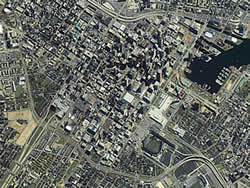cartome.org
7 June 2002
Source: http://www.spaceimaging.com/newsroom/releases/2002/sumofallfears.htm
For Immediate Release: May
31, 2002
"The Sum Of All Fears" Uses High-Resolution IKONOS Satellite Imagery
To Create Hollywood Magic
Space Imaging Product Provides Realism to Key Movie Scenes to Media
DENVER, May 31, 2002 - Movies
often push the truth when depicting scenes of advanced technology. However,
The Sum of All Fears, which opened May 31, is the first film to use and properly
portray high-resolution satellite imagery that has only recently been available
outside of the intelligence community.
Denver-based Space Imaging
supplied satellite images, worth approximately $90,000, to Los Angeles visual
effects shop Rhythm & Hues Studios for its work on scenes in the Paramount
Pictures film based on the Tom Clancy book. The images are used as transitional
elements in the movie, presenting incredibly realistic zoom-in scenes of seven
locations around the globe: the Federal Emergency and Management Agency (FEMA)
headquarters (Mt. Weather, Va.); CIA headquarters (Langley, Va.); Baltimore;
Damascus, Syria; Vienna, Austria; Haifa, Israel; and Sarova, Russia.

:: click to view larger image ::
Space Imaging supplied satellite images similar to this one of Baltimore, Maryland
to Los Angeles visual effects shop Rhythm & Hues Studios for its work on
scenes in the Paramount Pictures film based on the Tom Clancy book.
"Hollywood has always been enamored with satellite imagery, but few films
outside of The Sum of All Fears have depicted high-resolution images and capabilities
in a realistic manner," said Mark Brender, Space Imaging's executive director
of Government Affairs and Corporate Communications. "Tom Clancy is known
for his painstaking research and realism. This movie is the first to use real
satellite imagery in a major way."
IKONOS is the world's first commercial high-resolution imaging satellite. It
is capable of providing one-meter resolution images of virtually any place on
Earth. One-meter resolution means that objects as small as one meter squared
on the ground can be recognized. Although IKONOS can't distinguish objects as
small as individual people, it can show individual cars from its orbit 423 miles
in space. "Movie director Phil Alden Robinson wanted to use transitional
elements in The Sum of All Fears to help orient the audience to various locations,"
said Thomas Moore, pipeline setup technical director at Rhythm & Hues. "To
achieve this, we used high-resolution satellite imagery in such a way that the
imagery doesn't stand out," Moore said. "We didn't want the elements
to be too flashy, as had been done in other films. We wanted the elements to
look like realistic satellite images."
For example, the director
wanted the Baltimore shot to include the harbor at night. Since it is rare to
find high-resolution satellite images taken at night, the Rhythm & Hues
staff altered an IKONOS image to look as if it had been taken at night. Because
the field of view needed to include the harbor and city, Moore noted, four images
were used, scaled down and pieced together to create a full city image. To make
the image less static, Rhythm & Hues created the image to be too large to
project so that it could be panned slightly. A combination of digital painting
and numerous reference photographs were used to painstakingly recreate the city
of Baltimore at night.
High-resolution satellite
imagery will continue to be used in films, Moore predicts. "With this type
of data commercially available and half-meter imagery soon available, Hollywood
can create realistic satellite images, providing audiences with a new level
of detail, accuracy and entertainment," he said.
About Rhythm & Hues
Studios
Rhythm & Hues Studios is an Academy Award-winning film production studio
specializing in visual effects for feature films, television commercials, theme
park rides, music videos and interactive games. Its staff of more than 300 includes
live-action and animation directors, animators, painters, modelers, producers,
programmers, writers, and technical and production personnel. The studio won
the Best Visual Effects Academy Award for its work on Babe. More information
can be found at www.rhythm.com.
About Space Imaging
Space Imaging is a leading supplier of visual information products and services
derived from space imagery and aerial photography. The company launched the
world's first one-meter resolution, commercial Earth imaging satellite, IKONOS,
on Sept. 24, 1999. Other products are produced from the Indian Remote Sensing
satellites, U.S. Landsat, and Canada's RADARSAT. Space Imaging also delivers
aerial-derived imagery products collected by its own Digital Airborne Imaging
System (DAIS-1(tm)). For detailed information about Space Imaging, visit its
Web site at www.spaceimaging.com.
